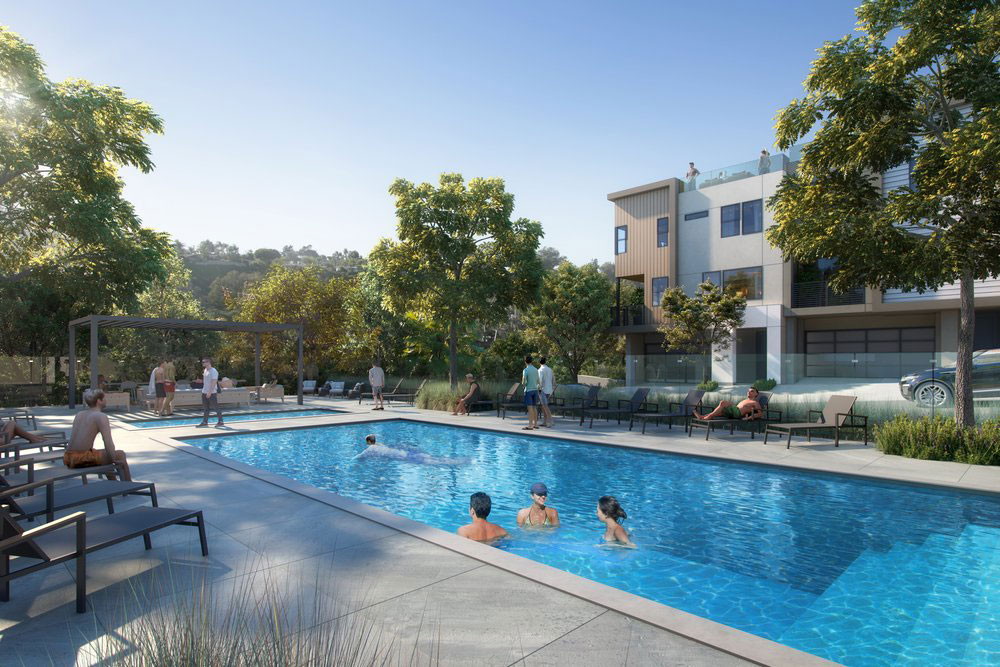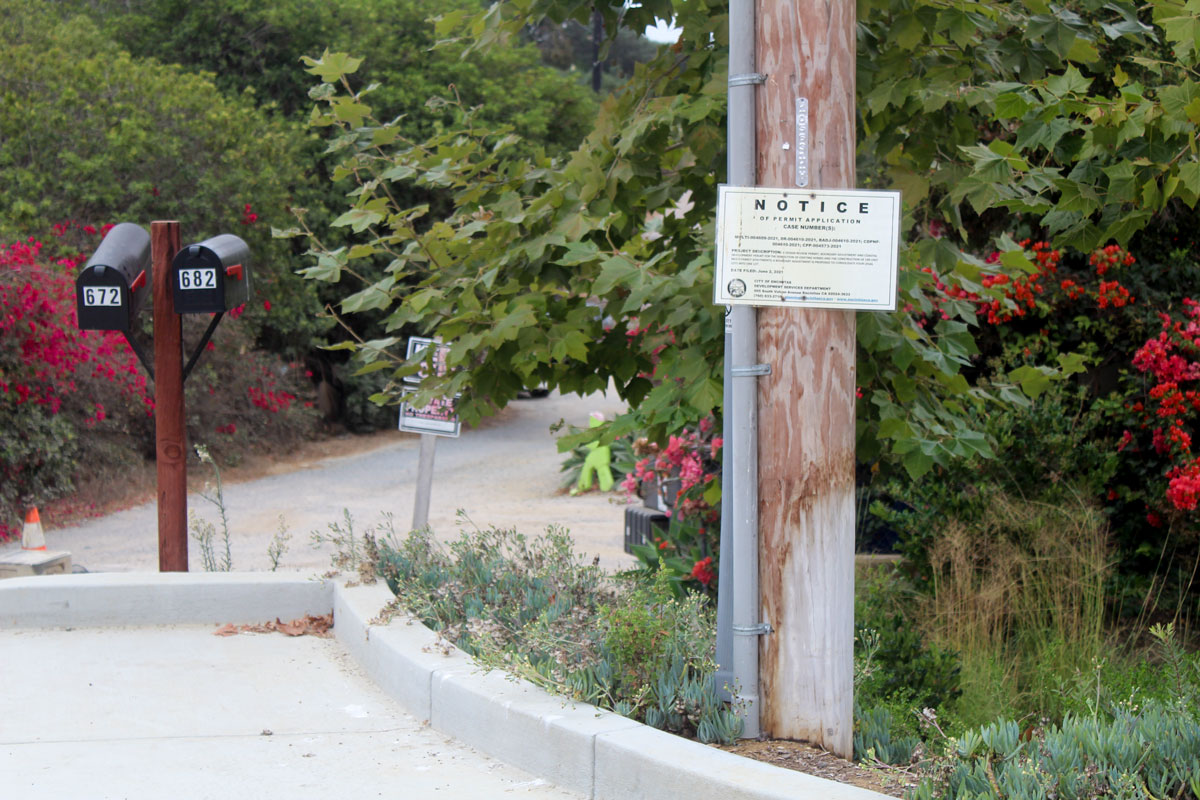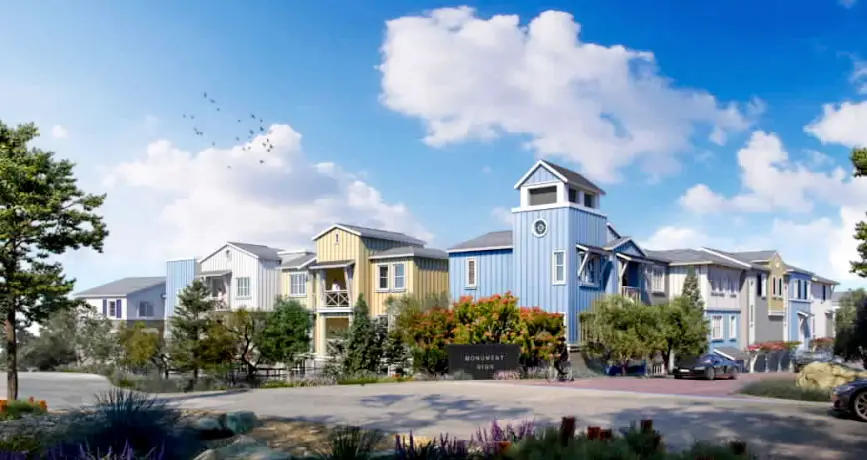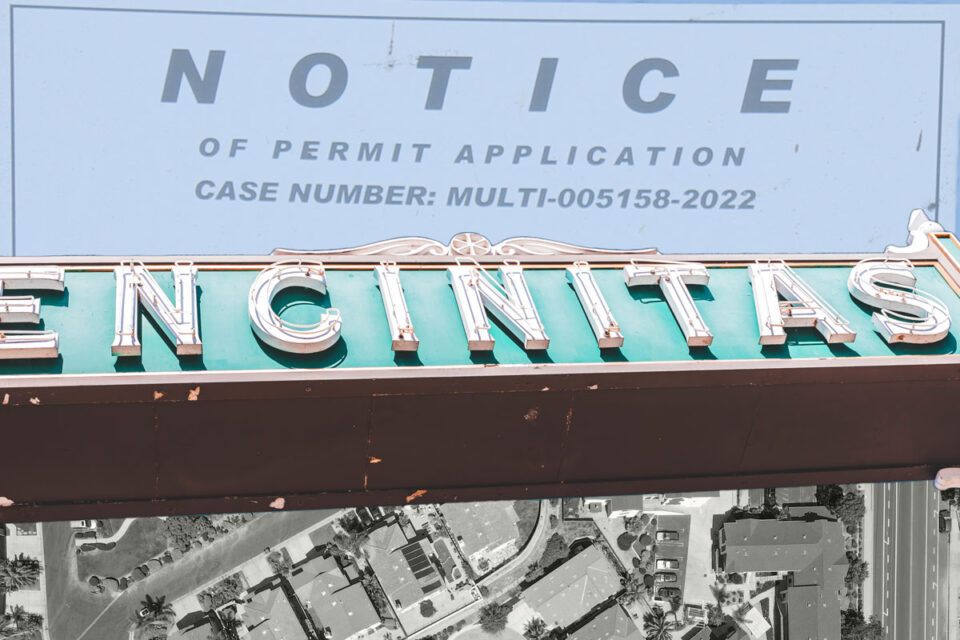In 2019, the Encinitas City Council adopted its 6th Cycle Housing Element Update for 2021-29, establishing 16 viable sites to accommodate 300 affordable housing units to meet the city’s requirements under the Regional Housing Needs Allocation or RHNA.
Among the 16 sites include Piraeus Point, Clark Avenue, Marea Village, Vulcan Avenue (locally known as “1967 Vulcan”), and Encinitas Boulevard, or the “Goodson Project.”
Some of these projects have already been approved or rejected by the city’s Planning Commission, but all will ultimately require the council’s approval.
But as elected officials make critical decisions about the future of affordable housing in Encinitas, many longtime residents and some local political candidates, particularly in Leucadia, are expressing concern and outrage over the anticipated impacts these projects will have on local infrastructure.
“There’s been so much high-density housing projects all in northwest Leucadia. It’s time for the city to step up and invest in infrastructure in this area,” said Bruce Ehlers, former planning commission chairman and District 4 council candidate. “You have to think about the cumulative effect of traffic being generated. The city owes Leucadia infrastructure to mitigate the cumulative effect of these developments.”
Many residents argue that projects such as Piraeus Point, Clark, and Goodson will exacerbate traffic congestion along major thoroughfares while leaving longtime locals and newcomers with nowhere to park their vehicles.
Others warn of the future developments’ disastrous impacts on emergency vehicle response times or evacuation safety in a major disaster, such as a wildfire. Looming over these projects is the question of how new developments will impact air quality. Some studies indicate the projects could substantially increase the risk of respiratory illnesses or even cancer.
Piraeus Point
Piraeus Point is a 6.9-acre development located at the corner of Piraeus Street and Plato Place just east of Interstate 5 that is anticipated to bring 149 townhomes, 15 of which will be classified as “affordable” for low-income households.
According to sources familiar with the matter, the project is expected to come for a vote before the Planning Commission in March 2023. The developers behind the proposal are Nolen Communities, a San Diego-based developer, and Lennar Properties, a homebuilding megalith headquartered in Florida.

Piraeus Point has already faced heavy criticism from locals worried about how the development would impact traffic, parking availability, air quality, landslide risks, and other concerns.
The project is primarily opposed by the local group Encinitas Community Collective (ECC), which compiled a comprehensive environmental analysis of the project in June. The group sent their findings to the project developers, outlining a host of risks tied to the proposal.
“It is evident that this environmentally sensitive bluff site is totally inappropriate to construct 16 monolithic densely packed 3-story structures with 149 townhomes housing more than 350 to 500 people, with an excess of 300 vehicles,” the group wrote in a letter to the developers. “The project is undeniably ill-conceived.”
In particular, the letter, written by the group’s founders Dennis Kaden, Karen Kaden and David Hill, claims the project is gravely under-parked and violates existing parking requirements under the municipal code.
As currently designed, Piraeus Point would hold 256 parking spots, including resident and guest parking. But the group calculates that the project to comply with city parking codes, specifically Encinitas Municipal Code Chap. 30.40.50, the actual number of spots should be 365, leaving the development 109 spots or 42% short of meeting the city’s parking requirement.
Since most of the streets adjacent to Piraeus Point do not have legal street parking, the project’s development would result in a parking “nightmare” for future Piraeus Point residents and those living on nearby streets, according to Hill, a retired engineer and principal author of the group’s environmental review.
“There’s no parking on Piraeus itself, there’s no parking on Skyloft Road, there’s no parking from La Costa Avenue in the north to Leucadia Boulevard to the south, no parking on Olympus for parents taking their kids up to (Capri Elementary) school,” Hill said. “So any parking generated by this project has to be on-site, and right now, it’s inadequately parked. What you end up with on this project is 500 people with 300 cars on 4 acres. It’s a gallon being dumped into a pint pot, a mass of concentrated humanity, and there’s no quality of life to go along with it.”
Hill reiterated these concerns in a letter to the city’s Planning Commission earlier this year.
“The current parking plan is inadequate to meet basic health, safety, and habitability needs of the residents,” Hill wrote. “Failure to plan for and provide off-street parking as part of this development reasonably and foreseeably jeopardizes the safety of pedestrians and vehicles on nearby streets. It also negatively impacts the quality of life for all neighborhood residents.”
Brian Grover, owner of Nolen Communities and lead developer for Piraeus Point, argued the group’s parking-needs analysis was flawed, ignoring the types of homebuyers — Couples, young families — attracted to the development to begin with.

“With parking, what they’re not looking at is that people in smaller townhomes like this live very differently than other residents,” Grover said. “You’re attracting a type of homebuyer that doesn’t plan on hosting a bunch of people over for Thanksgiving dinner. These are smaller houses set up for a starter family, maybe a couple with one younger child. So the 365 number for [parking] they came up with doesn’t pan out.”
Grover also pointed out that developers have a clear market incentive to ensure residents have adequate parking and guaranteed that parking from the project would not spill over onto neighboring side streets, such as Caudor Street and Plato Place.
“If you think about it, if we as the developer build homes without parking, we’re not going to sell homes,” Grover said. “I guarantee that site parking will not spill over onto the [side streets]. And I’m willing to sign that into our CC&Rs (a declaration of covenants, conditions and restrictions signed by the developer for county records to maintain property value).”
In addition to being under-parked, Encinitas Community Collective also argues that Piraeus Point will substantially worsen existing traffic congestion, particularly on Caudor, Piraeus, and at the intersection of Urania Avenue and Leucadia Boulevard heading southbound.
According to the group’s calculations, the development would generate a minimum of 1,800 new vehicle trips daily. Capri Elementary School, located just east up the hill from Piraeus near the intersection of Capri and Burgundy roads, will likely suffer the most from the development’s added congestion, Hill and the Kadens maintain.
Hill’s letter to the Planning Commission notes the current backup issues around Capri Elementary. The letter claims that as designed, Piraeus Point would feed traffic directly onto Caudor, exacerbating existing gridlock around the school while making the area more dangerous for vehicle commuters, school children and other pedestrians.
“We’re concerned about pedestrian safety and health,” said Karen Kaden. “Traffic already backs up Urania, Caudor and Plato, ending up with gridlock on Capri. With this [project], Plato especially will become concerning for children and parents trying to walk up to Capri school. We’re also very concerned about pedestrian and commuter safety alongside Piraeus itself.”
Grover said the group’s traffic analysis incorrectly assumed which streets the project’s residents would choose to navigate. Per the developer’s independent study of traffic flows in the community, site residents heading east towards commercial activity further inland are less likely to utilize the neighboring side streets around Capri (Urania, Caudor, Plato) and would instead take La Costa Boulevard towards El Camino Real, resulting in a relatively minimal impact on neighborhood congestion, Grover said.
“The real issue is how people get east from [Piraeus Point]. The notion that our residents are going to navigate through these residential neighborhoods to get to Leucadia Boulevard to go east is a notion that isn’t supported by our own traffic analysis,” Grover said. “They won’t take Piraeus onto Plato and go onto these neighborhood streets filled with stop signs and relatively low-speed limits. Instead, our analysis shows that taking La Costa to El Camino is the fastest route by far.”
Grover acknowledged an influx of school-age children from young families living at Piraeus Point would likely feed some additional traffic into the gridlock at Capri during pick-up and drop-off hours. However, the developer argued that solving the current and future congestion at the school was a question for the city to tackle and not their responsibility.
“Are we going to have school-age children from this community attend Capri? Yes. The disconnect is that we can’t fix preexisting problems on these public streets,” Grover said. “For example, we can ask the city to create safer sidewalks for kids to be able to walk to school and start that process, but ultimately all that we can control is our own private property.

“The fact that there’s not enough room for pedestrians and that people drive too fast on these roads, that’s not something within our control. This is the city’s responsibility to improve these roads and reduce existing congestion, and we’re just here to help however we can.”
Encinitas Community Collective is just as concerned about the large volume of greenhouse gas emissions anticipated to come from Piraeus Point, which the group said is harmful to the city’s climate action goals and poses serious health risks for the community.
Hill said he’s worried about the sheer volume of emissions from the additional 1,800-plus vehicle trips per day coming from the development. But he’s also concerned because of the project’s proximity to I-5, which lies just 200 meters east.
“From (Piraeus Point), you’re getting emissions, and you’re getting greenhouse gases — you have emissions from the petroleum gases, from methane, ethane, and you’ve got carbon monoxide gases, Hill said. “They just widened the I-5, which now sees 175,000 vehicles a day, so yes, the air quality is a serious health issue in terms of creating respiratory issues such as asthma for adults and children with greenhouse gases. And then there’s a whole set of issues here with cancer-causing agents. The respiratory effects of living this close to the freeway are clear.”
According to the group’s environmental analysis, high-density development is another reason to worry about the effects of greenhouse gas emissions.
“The carcinogen pollutants and particulates will be breathed and absorbed and will affect every one of the Piraeus Point Townhome residents and the surrounding community residents,” the report reads. “The air quality impact of Piraeus Point Townhomes will be significant due to the density of the 149 townhomes on 6.93 acres or less. The accumulation of gasoline/petroleum base pollutants, i.e., greenhouse gases (GHGs), will be significant and injurious to the health of not only the 455 residents or more but also the surrounding community.”
The prevailing winds in the community will further complicate the health risks for site residents and neighbors.
“The on-site source of airborne pollutants will rise vertically between the 149 row-type structures into open windows and also transported by the southwest to the northeast prevailing wind to the community,” the report states. “Therefore, the carcinogen pollutants and particulates will be breathed, absorbed and will affect every one of the Piraeus Point townhome residents and the surrounding community residents.”
But Grover argues that the ECC report on emissions ignores the townhomes’ unique energy efficiency and discounts the developer’s mitigation measures to minimize emissions.
“These homes will be several times more sustainable in terms of carbon emissions than many of the older, larger homes in the community,” Grover said. “We have solar rooftops and pre-plumbed electronic vehicle charging in every single garage, among other features. This project is fully consistent with the city’s green building ordinance, and there’s absolutely no natural gas usage.”
While acknowledging the project would result in an overall uptick in emissions, Grover pointed out that the development was consistent with the city’s green energy goals with mitigation measures. The developer repeatedly emphasized that Piraeus Point’s design pushes site residents towards electric vehicle usage, which he argued is a unique advantage for the site in terms of lowering overall emission production.
“Yes, this is going to increase GHGs, but it’s already accounted for in the city’s inventory, and these homes will be more GHG efficient than any other home today,” Grover said. “We’re an all-electric community, and with these charging stations, we’re pushing our residents to drive all-electric vehicles. So you are more likely to have more electric vehicles versus gas-powered vehicles than any other community.
“When you boil it down, what emissions are we creating besides those from vehicles? We don’t have fireplaces (woodburning or natural gas), we have solar on all our rooftops, and we’re all-electric.”
Regarding air quality risks from the site’s proximity to the freeway, Grover pointed to Ldn Consulting’s health risk assessment study. The study concluded that with planned mitigation measures, the project fell within state guidelines of the acceptable threshold for cancer risk.
“We saw (ECC’s) comments in the letter, and that’s why we commissioned this health risk assessment to analyze the impacts of I-5 traffic on residents,” Grover said. “And the results show that the risk (of cancer) is less than significant. The results of this health risk assessment answer these questions pretty clearly and close the book on this, from my view.”
Clark Avenue Apartments
The 199-unit apartment complex is proposed on a 6.22-acre site east of Interstate 5 and west of Poinsettia Park. The site would contain 15 three-story buildings with 40 affordable housing units.
The Encinitas Planning Commission on Aug. 4 unanimously denied the project. According to Councilman Tony Kranz, Western National Properties’s developer plans to appeal the commission’s decision to the council.
Local activists affiliated with the Clark Development Action Group (CDAG) contend that the development would substantially increase traffic in northwestern Leucadia, slowing down emergency vehicle response times while posing significant risks to evacuation safety in the event of a major disaster such as a wildfire.
“You’re creating a fire hazard and the potential for deaths with (the Clark) project — it’s an absolute disaster,” said former Encinitas mayor Sheila Cameron.

“My main concern about this project is the lack of planned infrastructure for an already overburdened community and already overburdened streets and roads,” said Cindy Cremona, leader of CDAG and mayoral candidate. “This project will devastate the community.”
Craig Sherman, an attorney representing CDAG, believes the project will overtax the current infrastructure.
“Clark didn’t get any real review or overview regarding the projected impact on traffic,” Sherman said. “It’s the worst fit of any project from a circulation standpoint; it’s just a disaster.”
Critics say they’re concerned about how the project will impact traffic on an already congested Clark Avenue, a two-lane roadway from Leucadia Boulevard south towards I-5.
The only point of access into the development is from Union Street to the south, while egress would be at Union and Clark. Cremona believes traffic coming into and out of the project will inevitably back up on the side streets parallel to Clark, including La Mirada Avenue, Del Riego Avenue, Del Rio Avenue and Saxony Road to the east.
While the developer conducted a traffic study concluding there would be “no substantial traffic impact on an already underperforming intersection,” Cremona and others with CDAG point out that this study was conducted in June 2020, at the height of the COVID-19 pandemic, when statewide stay-at-home orders largely suppressed rush-hour traffic.
According to Sherman, the Clark development’s location presents a unique set of challenges for its future residents, especially regarding ingress and egress.
“This project is nowhere near major transit. It’s in a setting of backwoods sites and substandard roads,” Sherman said. “And on top of that, it’s in an area where there’s not an easy way to get in and out of based upon its location; there’s really only one or two ways out.”
The gridlock on Clark, Saxony, and Union will be so severe that it will invariably impact emergency vehicles’ response times in the corridor, according to traffic analysis by Darnell & Associates, a traffic engineering firm hired by Sherman. The project’s traffic analysis, spelled out earlier this month to the City Council, lays out evacuation safety concerns during a significant disaster.
“Emergency Services may have limited access due to congestion issues and substandard roadway, particularly on Clark Avenue,” the letter reads. “Fire services, particularly, will be impacted due to substandard street width, higher traffic volumes, and parking on Clark Avenue. This will also create an unacceptable potential fire danger to the public that will reside at the site of the Clark Project and the surrounding neighborhood if Clark Avenue is not improved.”

The traffic analysis predicts the project would also inevitably lead to increased collisions along the northwestern Leucadia corridor.
“The increase in traffic, and types of vehicles, without roadway improvements, will significantly increase the likelihood of collisions on Clark Avenue and at the intersections at Clark Avenue/Leucadia Boulevard, Union Street/Saxony Road and on Clark Avenue between Puebla Street and Leucadia Boulevard due to the substandard roadway conditions,” the letter reads.
The concerns, laid out by the firm’s consultants, were echoed in another letter written in April to the Planning Commission by the city’s Mobility and Traffic Commission, wherein Chairman Michael Von Neumann expressed the commission’s reservations about how the development would impact emergency vehicle response times on Clark Avenue.
“The Clark Avenue roadway is only improved on one side of the street, and parking is permitted on both sides,” Neumann said. “This narrows the access to essentially one lane, making emergency access difficult.”
In Sherman’s letter to the council, the attorney said his firm also hired consultants to review the Clark project’s environmental impacts to examine how the development would affect residents’ air quality.
“CDAG’s retained experts conclude, and provide evidentiary support, based on objective science and identifiable standards, that the Clark Project will… increase the probability of cancer and respiratory illness to residents and surrounding neighbors due to the substantially increased emissions and violation of objective health standards,” the letter reads.
In contrast, an analysis performed by a developer-hired consulting firm SWAPE in 2021 concluded that Clark would have a “less-than-significant air quality impact.” But according to SWAPE, that study was systematically flawed, severely underestimating the project’s total emissions, especially during the construction and grading phases.
SWAPE’s analysis found toxic air emissions produced during the project’s construction and daily operations would increase cancer risks for Clark residents by nearly five times the maximum acceptable risk threshold under San Diego County health standards.
“We had our consultant review air quality and particulates for [Clark], and it’s very problematic. The environmental concerns and circumstances from this project are pretty extreme,” Sherman said. “This type of project undermines a lot of greenhouse gas goals, VMT (vehicle miles traveled) goals, and it’s not transit-oriented.”

Cremona also voiced her concerns with air quality.
“With this project being 50 feet away from the [I-5] freeway, we have definitive concerns about Clark’s noise and air pollution,” said Cremona. “The end impacts of this will be more air pollution and noise pollution, with a high volume of cars stuck in traffic idling on Clark, on Saxony, idling on Union. This project will be catastrophic for the community from an air quality standpoint.”
For Cremona and other members of CDAG, the Clark project is equally problematic from a social justice standpoint, given the project’s proximity to the historically Mexican-American community of Tortilla Flats, which consists of numerous multigenerational households with relatively lower incomes.
“This community is getting kicked to the curb and taken advantage of, and the developer knows they don’t have the money to fight this if this project gets approved,” said Cremona, who also lives in the neighborhood. “Many of these neighbors belong to blue-collar families and work multiple jobs, some don’t speak English, and they’re living in multigenerational homes. I’ve spoken to many people who have lived here for 30-40 years, and they’re upset, worried, and understand that the traffic implications, particularly on the Clark side, will be devastating for us.”
“You can’t ignore the racial aspect of all of this, with this being a Hispanic community where 43% of residents speak Spanish. This is just a terrible situation and a hardship for these people. They don’t have the money to fight this, and everyone knows it.”
The letter from Sherman’s firm to the city highlighted the racial justice element of the development.
“The nearby and adjacent Tortilla Flats neighborhood is a historic Mexican-American neighborhood that is medium- to low-income. In other words, the Tortilla Flats community is both socioeconomically disadvantaged and a racial minority,” the letter reads. “Environmental justice elements are a required part of general plans. (Cal. Gov. Code § 65302, subd. (h)(1)), and this Planning Commission should remain vigilant against developers pushing through projects that adversely and unfairly impact unique and underprivileged communities, such as Tortilla Flats, that may not have the financial resources to advocate and enforce the laws in their community adequately. The residents of Tortilla Flats have the same right to clean air and proper capacity and project-serving and community roads.”
The developer, Western National Properties, could not be reached for comment on this article.
EDITOR’S NOTE: This is the first article in a two-part series on infrastructure and housing developments in Encinitas.




2 comments
Catherine Blakespear and Tony Kranz, along with their puppet Joy Lyndes have done their best to destroy Encinitas.
Every one of them should never be able to win another election.
People need to realize that The Democratic Party of California doesn’t exist anymore, it is now The Developer Party of California and all endorsed candidates have to pledge fealty to State control over local housing and SB9.
Blakespear is a synonym for corruption.
If you want to see change you have to vote for change
Matt Gunderson for State Senate
Cindy Cremona for Mayor
Julie Thunder for D3
Bruce Ehlers for D4
It’s that easy
Great article @StephenWyer. Thanks for keeping a light on all the development projects in the Encinitas area.
Comments are closed.